牛津上海版七年级上册U2教案
- 格式:docx
- 大小:42.57 KB
- 文档页数:9
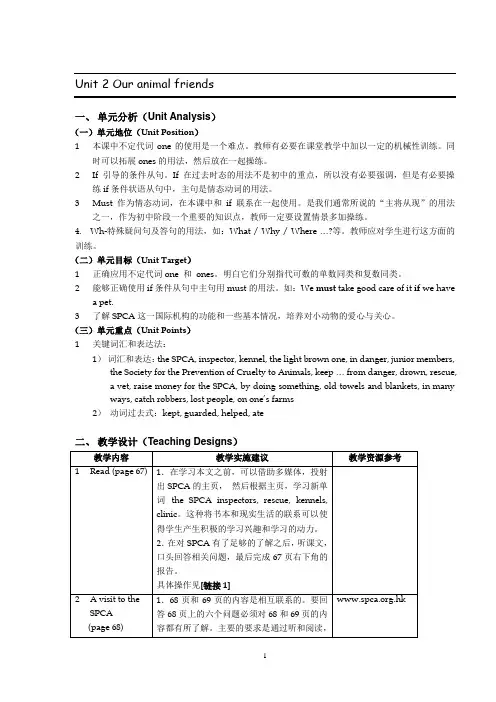
Unit 2 Our animal friends一、单元分析(Unit Analysis)(一)单元地位(Unit Position)1 本课中不定代词one的使用是一个难点。
教师有必要在课堂教学中加以一定的机械性训练。
同时可以拓展ones的用法,然后放在一起操练。
2 If 引导的条件从句。
If 在过去时态的用法不是初中的重点,所以没有必要强调,但是有必要操练if条件状语从句中,主句是情态动词的用法。
3 Must 作为情态动词,在本课中和if 联系在一起使用。
是我们通常所说的“主将从现”的用法之一,作为初中阶段一个重要的知识点,教师一定要设置情景多加操练。
4. Wh-特殊疑问句及答句的用法,如:What / Why / Where …?等。
教师应对学生进行这方面的训练。
(二)单元目标(Unit Target)1 正确应用不定代词one 和ones。
明白它们分别指代可数的单数同类和复数同类。
2 能够正确使用if条件从句中主句用must的用法。
如:We must take good care of it if we havea pet.3 了解SPCA这一国际机构的功能和一些基本情况,培养对小动物的爱心与关心。
(三)单元重点(Unit Points)1 关键词汇和表达法:1)词汇和表达:the SPCA, inspector, kennel, the light brown one, in danger, junior members, the Society for the Prevention of Cruelty to Animals, keep … from danger, drown, rescue,a vet, raise money for the SPCA, by doing something, old towels and blankets, in manyways, catch robbers, lost people, on one’s farms2)动词过去式:kept, guarded, helped, ate二、教学设计(Teaching Designs)●What does SPCA mean?(学生的中文回答是可以的,因为只要有一个概念就可以了)●The SPCA inspectors work for the SPCA and rescue animals.●Dogs live in the kennels and wait for their hosts.●If a dog is ill, it should go to the clinic.学生在教师的讲解和生动的图片引导下,会对以上生词的概念有所掌握。
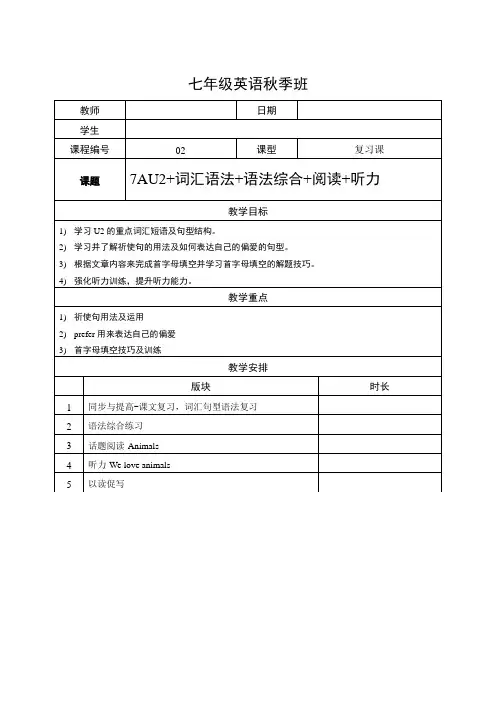
七年级英语秋季班1. 7A U2同步与提高Part 1 课文ReviewAnimals, our friendsThe SPCA is an organization which helps protect animals. Every year, it s_____1_____ a lot of animals in Garden City. Sometimes people are u_____2_____ to their pets. They don’t take c_____3_____ of their pets and leave them in the street. SPCA o_____4_____ save them from danger and take them to the SPCA.The SPCA a_____5_____ helps animals find new homes. If people want to _____6_____ a pet, they can go to the SPCA. H_____7_____, they must promise to look after their new pet.There are clinics for those animals who are s_____8_____ in the SPCA. The vets in the clinics take care of them.Part 2 根据音标写单词7A U2 Vocabulary(牛津)序号英文音标词性中文1 ['ɒfɪsə] n. 官员;高级官员2 [sə'saɪətɪ] n. 社团;协会3 [prɪ'venʃn] n. 预防;防止;防范4 ['krʊəltɪ] n. 残酷5 ['sʌmwʌn] pron. 某人6 ['pʌpɪ] n. 小狗;幼犬7 ['θɜːstɪ] adj. 口渴的8 ['lʌvlɪ] adj. 可爱的;有吸引力的9 [æz] prep. 作为;当作10 [prɪ'fɜː]v. 更喜欢11 [keə] n. 照料;照顾Part 3 词汇语法复习Grammar2. 祈使句一、定义:祈使句是用来表示请求、命令、劝说、号召、警告等的句子。
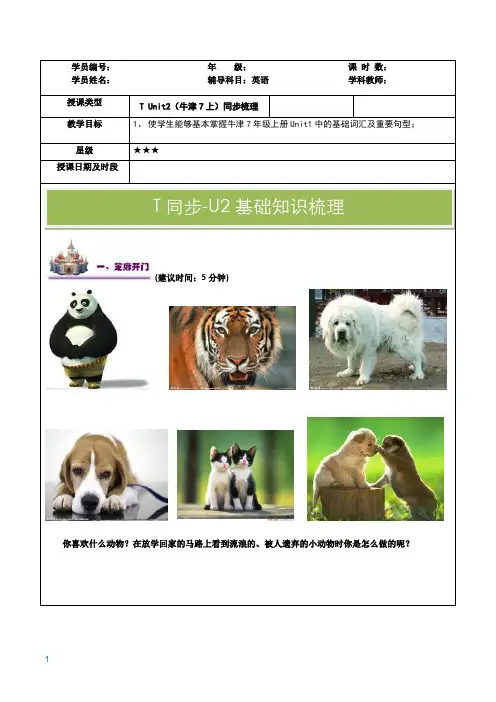
学员编号:年级:课时数:学员姓名:辅导科目:英语学科教师:授课类型T Unit2(牛津7上)同步梳理教学目标1、使学生能够基本掌握牛津7年级上册Unit1中的基础词汇及重要句型;星级★★★授课日期及时段T同步-U2基础知识梳理(建议时间:5分钟)你喜欢什么动物?在放学回家的马路上看到流浪的、被人遗弃的小动物时你是怎么做的呢?一、词汇Words (建议20分钟,老师边讲边要求学员记住单词,此环节结束之后要求学员记住80%)1. officer n. 官员;高级官员【词性转换】office n. 办公室e.g. A police officer came to help when our car broke down on the way.我们的汽车在路上出了毛病,一位警官帮了我们的忙。
2. society n. 社团;协会【词性转换】social adj. 协会的;社会的e.g. the Chemical Society of China 中国化学学会3. prevention n. 预防;防止;防范【词性转换】prevent v. 预防;防止e.g. Prevention is better than cure. 预防胜于治疗。
批注:prevent和protect,很多孩子分辨不清楚,还应该让孩子注意protect的名词形式是protection。
4. cruelty n.残酷【词性转换】cruel adj. 残酷的;悲惨的e.g. cruelty to children 虐待儿童5.someone pron. 某人【近义词】somebody pron. 某人;有人e.g. Someone wants to talk with you. 有人想和你谈话。
6. puppy n. 小狗;幼犬【提示】dog一般用来指“成年狗”或表示狗的总称;puppy特指小狗,复数形式为puppies7. thirsty adj. 口渴的【词性转换】thirst n. 口渴e.g. I often feel thirsty when it’s very hot. 天热时,我常感到口渴。
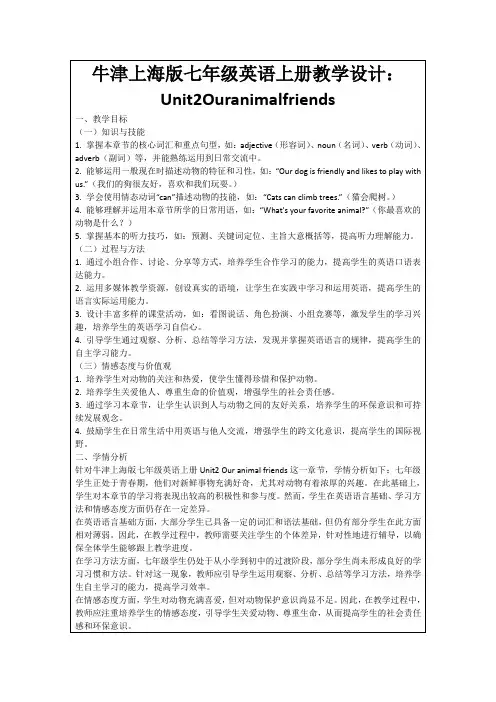
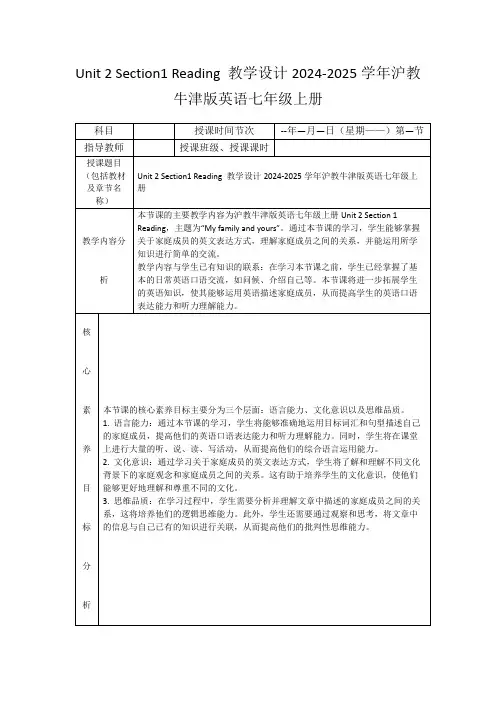
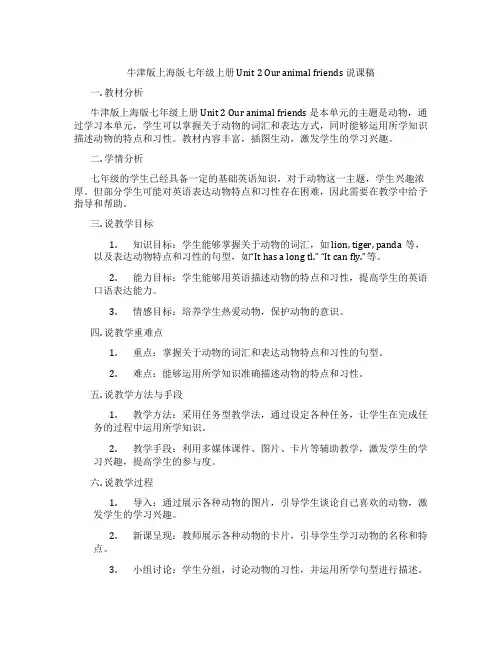
牛津版上海版七年级上册 Unit 2 Our animal friends 说课稿一. 教材分析牛津版上海版七年级上册Unit 2 Our animal friends 是本单元的主题是动物,通过学习本单元,学生可以掌握关于动物的词汇和表达方式,同时能够运用所学知识描述动物的特点和习性。
教材内容丰富,插图生动,激发学生的学习兴趣。
二. 学情分析七年级的学生已经具备一定的基础英语知识,对于动物这一主题,学生兴趣浓厚。
但部分学生可能对英语表达动物特点和习性存在困难,因此需要在教学中给予指导和帮助。
三. 说教学目标1.知识目标:学生能够掌握关于动物的词汇,如lion, tiger, panda等,以及表达动物特点和习性的句型,如“It has a long tl.” “It can fly.”等。
2.能力目标:学生能够用英语描述动物的特点和习性,提高学生的英语口语表达能力。
3.情感目标:培养学生热爱动物,保护动物的意识。
四. 说教学重难点1.重点:掌握关于动物的词汇和表达动物特点和习性的句型。
2.难点:能够运用所学知识准确描述动物的特点和习性。
五. 说教学方法与手段1.教学方法:采用任务型教学法,通过设定各种任务,让学生在完成任务的过程中运用所学知识。
2.教学手段:利用多媒体课件、图片、卡片等辅助教学,激发学生的学习兴趣,提高学生的参与度。
六. 说教学过程1.导入:通过展示各种动物的图片,引导学生谈论自己喜欢的动物,激发学生的学习兴趣。
2.新课呈现:教师展示各种动物的卡片,引导学生学习动物的名称和特点。
3.小组讨论:学生分组,讨论动物的习性,并运用所学句型进行描述。
4.实践环节:学生分角色扮演,模拟描述动物的特点和习性。
5.总结提升:教师引导学生总结本节课所学内容,强调保护动物的重要性。
七. 说板书设计板书设计如下:Our animal friends•Lion: It has a long tl.•Tiger: It has four legs.•Panda: It is black and white.八. 说教学评价教学评价采用形成性评价和终结性评价相结合的方式。
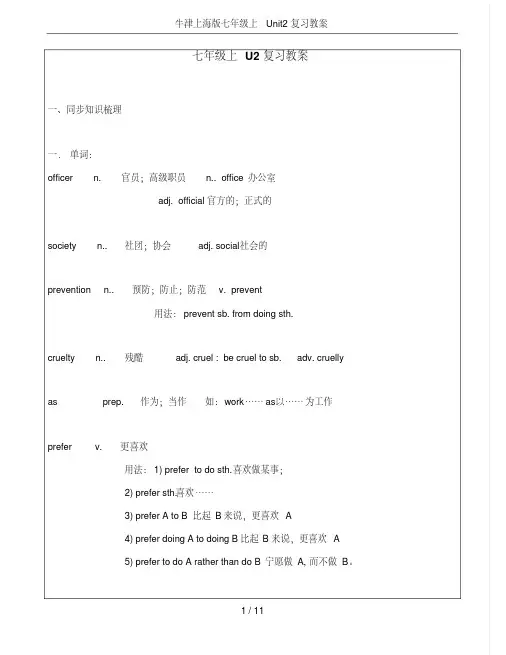
七年级上U2复习教案一、同步知识梳理一.单词:officer n. 官员;高级职员 n.. office 办公室adj. official 官方的;正式的society n.. 社团;协会 adj. social 社会的prevention n.. 预防;防止;防范 v. prevent用法:prevent sb. from doing sth.cruelty n.. 残酷 adj. cruel : be cruel to sb. adv. cruelly as prep. 作为;当作如:work……as 以……为工作prefer v. 更喜欢用法:1) prefer to do sth. 喜欢做某事;2) prefer sth. 喜欢……3) prefer A to B 比起B来说,更喜欢 A4) prefer doing A to doing B 比起B来说,更喜欢 A5) prefer to do A rather than do B 宁愿做A, 而不做B。
care n. 照料;照顾 adj. careful / careless n. carefulness / carelessness词组: take care of 照顾safely adv. 安全地; adj. safe n. safetypolice n. 警方该词做警方解释时是集体名词,没有复数形式,但后面的谓语动词要用复数。
thief n. 窃贼;小偷复数形式是:thieves v. thieve 偷missing adj. 失踪的 a missing boy = a lost boy 迷路的男孩v. missadj. missed二.词组:照看好look after …… well为……筹钱raise money for……保证做…… promise to do ……守护我们的家 guard our homes在很多方面 in many ways对……残忍be cruel to ……找到失踪的人 find lost people保护……使免受…… protect …… from浅棕色 light brown阻止,使免于…… keep……from欢迎来到…… welcome to ……把……扔在马路上 leave something in the street.愿意做…… would like to do something给……一碗水喝 give somebody a bowl of water to drink把……作为宠物keep …… as somebody’s pet三.课文中的语法点need 的用法:need 是个重要的词。
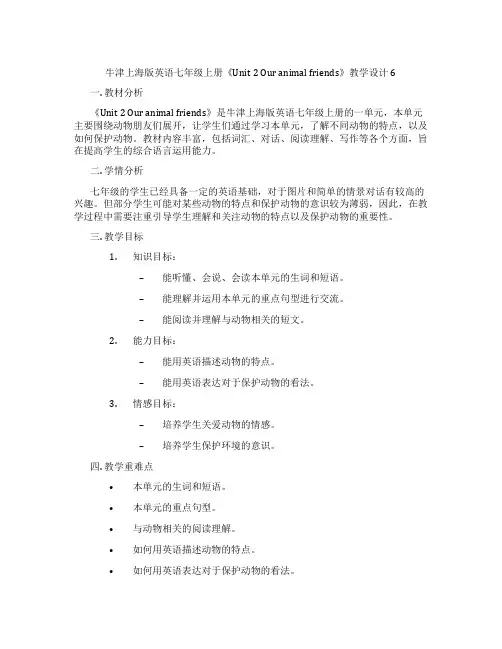
牛津上海版英语七年级上册《Unit 2 Our animal friends》教学设计6一. 教材分析《Unit 2 Our animal friends》是牛津上海版英语七年级上册的一单元,本单元主要围绕动物朋友们展开,让学生们通过学习本单元,了解不同动物的特点,以及如何保护动物。
教材内容丰富,包括词汇、对话、阅读理解、写作等各个方面,旨在提高学生的综合语言运用能力。
二. 学情分析七年级的学生已经具备一定的英语基础,对于图片和简单的情景对话有较高的兴趣。
但部分学生可能对某些动物的特点和保护动物的意识较为薄弱,因此,在教学过程中需要注重引导学生理解和关注动物的特点以及保护动物的重要性。
三. 教学目标1.知识目标:–能听懂、会说、会读本单元的生词和短语。
–能理解并运用本单元的重点句型进行交流。
–能阅读并理解与动物相关的短文。
2.能力目标:–能用英语描述动物的特点。
–能用英语表达对于保护动物的看法。
3.情感目标:–培养学生关爱动物的情感。
–培养学生保护环境的意识。
四. 教学重难点•本单元的生词和短语。
•本单元的重点句型。
•与动物相关的阅读理解。
•如何用英语描述动物的特点。
•如何用英语表达对于保护动物的看法。
五. 教学方法1.情境教学法:通过图片、实物、情景对话等方式,创设情境,让学生在实际情境中学习和使用英语。
2.任务型教学法:通过小组讨论、角色扮演等任务型活动,引导学生主动参与学习,提高学生的语言运用能力。
3.情感教学法:引导学生关注动物的特点和保护动物的重要性,培养学生的关爱动物情感和保护环境的意识。
六. 教学准备1.教学课件:制作与动物相关的课件,包括图片、视频等。
2.教学材料:准备与动物相关的阅读材料。
3.教学用具:录音机、磁带、单词卡片等。
七. 教学过程1.导入(5分钟)–利用图片或视频展示本节课的主要动物,引导学生谈论动物的特点,激发学生的学习兴趣。
2.呈现(10分钟)–呈现本节课的生词和短语,让学生听音认词,并用单词卡片进行操练。
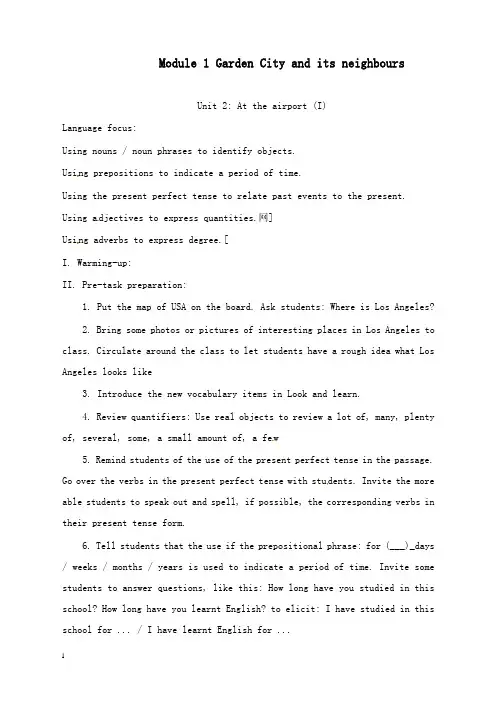
Module 1 Garden City and its neighboursUnit 2: At the airport (I)Language focus:Using nouns / noun phrases to identify objects.Using prepositions to indicate a period of time.Using the present perfect tense to relate past events to the present. Using adjectives to express quantities.网]Using adverbs to express degree.[I. Warming-up:II. Pre-task preparation:1. Put the map of USA on the board. Ask students: Where is Los Angeles?2. Bring some photos or pictures of interesting places in Los Angeles to class. Circulate around the class to let students have a rough idea what Los Angeles looks like3. Introduce the new vocabulary items in Look and learn.4. Review quantifiers: Use real objects to review a lot of, many, plenty of, several, some, a small amount of, a fe w5. Remind students of the use of the present perfect tense in the passage. Go over the verbs in the present perfect tense with stu dents. Invite the more able students to speak out and spell, if possible, the corresponding verbs in their present tense form.6. Tell students that the use if the prepositional phrase: for (___)_days / weeks / months / years is used to indicate a period of time. Invite some students to answer questions, like this: How long have you studied in this school? How long have you learnt English? to elicit: I have studied in this school for ... / I have learnt English for ...7. Play the recording: Look and learn and Look and read. Students listen and follow in their books.8. Play the recording again. Students listen and repeat.9. Students read the text individually and write down the answers to the questions in Answer true / false. Check the answers with the whole class. Invite the more able students to review the false statements into true ones on the board.III. Consolidation:Grammar Practice Book 7A page 4.Unit 2: At the airport (II)Language focus:Using “going to” to describe events that will occur quite soon.Asking “Wh-” questions to find out time.Using prepositions to indicate time.Asking “How” questions to find out the length of a period of time.Using prepositions to indicate a period of time.I. Warming-up.II. Pre-task preparation:1. Introduce new vocabulary items: departure and arrival. Make sure students can differentiate between the two. Also make sure students can differentiate between a.m. and p.m.2. Look, read and think.3. Play the recording again. Students listen and repeat.4. Invite three students to come to the front and role-play the conversation. Ask a more able student to act as Mr. Li in order to work out the time for leaving home. Encourage other students to supply any different answers.5. Ask students to read page 7 of the Student's Book again. They are required to write and draw the time. Students then help each other check answers in pairs.6. Have students work in pairs to read the dialogue in Ask and answer. Walk around and offer help and guidance to the less able students if necessary.III. While-task procedure:Draw the air tickets on the board and invite some volunteers to write the answers on the air tickets.IV. Post-task activity:Distribute a piece of drawing paper to each s tudent. Tell them to think about where they would like to spend a holiday and to draw their own air tickets with the relevant information. Collect the students' work and bind it into a booklet to be circulated in class.V. Consolidation: Grammar Practice Book 7A page 5.Unit 2: At the airport (III)Language focus:Using imperatives to give instructions and directions.Using nouns to identify objects.I. Warming-up:II. Pre-task preparatio1. Introduce new vocabulary items: trolleys and escalators. Put an enlarged photocopy of pictures of trolleys on the board. Point to the pictures and say: trolleys. Then put an enlarged photocopy of pic tures of escalators on the board. Point to the pictures and say: escalators. Make sure students know the correct pronunciation of the vocabulary items.2. Review / Introduce: exit and entrance. Make sure students can differentiate between the two.3. Have students look at the eight signs and read the eight descriptions in Read and match carefully. Then ask them to match each sign with the suitable description. Finally, the whole class checks answers together. Ask students to point to the signs and read the descriptions aloud.III. While-task procedure:1. Draw the eight signs on the board and invite volunteers to come forward and write the descriptions under the signs.2. Tell students to imagine that they are at the airport. Ask them to think of three more signs that they can see at the airport. Tell them to draw the signs and write theIV. Post-task activity:Ask students to draw the signs that can be seen at restaurants, shopping centres, supermarkets, cinemas, swimming pools and on underground, buses, ferries, planes, etc.Unit 2: At the airport (IV)Language focus:[Using nouns / noun phrases to identify objects.Using the present perfect tense to relate past events to the present. Using adverbs to express time.I. Warming-up:II. Pre-task preparation:1. Review and introduce new vocabulary items in Look and learn. You may explain the meanings of these vocabulary items with real objects or pictures.Read the words aloud. Have students repeat after you2. Look and learn and Say and act.3. Play the recording again. Students listen and repeat.4. Students practise in groups the target language in Say and act by role-playing Mr. Li, Mrs Li and Grandma. Invite a few groups to come out and role-play the conversation in class.5. Have students work in pairs to talk about the checklist in Think and write. Have them complete the checklist by writing down what they have discussed with their partners.III. While-task procedure:1. Students discuss and agree on five items for a checklist before leaving for Los Angeles. Have them complete the checklist by writing down what they have discussed with their partners2. Still in pairs, students read the dialogues on page 9 of the Student's Book again. Students have to write some dialogues and role-play with their partners. They are required to use the target language learned in Say and act.3. Ask for volunteers to act out the conversations.IV. Post-task activity:Workbook pages 3 and 4.V. ConsolidationGrammar Practice Book 7A pages 6 and 8.。
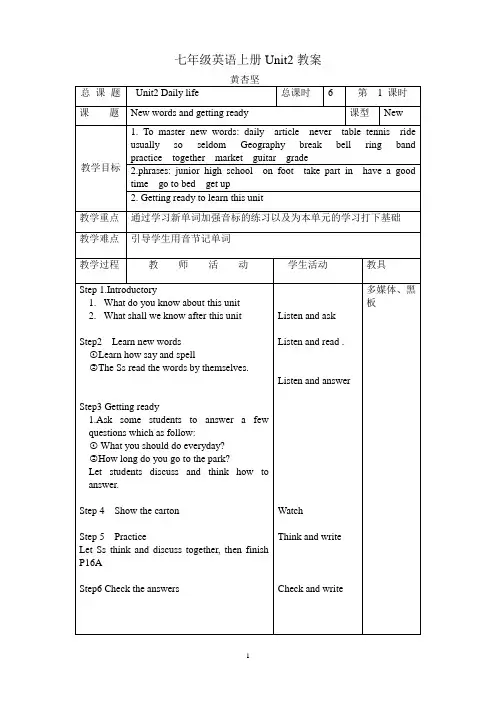
七年级英语上册Unit2教案黄杏坚总课题Unit2 Daily life 总课时 6 第 1 课时课题New words and getting ready 课型New教学目标1. To master new words: daily article never table tennis ride usually so seldom Geography break bell ring band practice together market guitar grade2.phrases: junior high school on foot take part in have a good time go to bed get up2. Getting ready to learn this unit教学重点通过学习新单词加强音标的练习以及为本单元的学习打下基础教学难点引导学生用音节记单词教学过程教师活动学生活动教具Step 1.Introductory1.What do you know about this unit2.What shall we know after this unitStep2 Learn new words①Learn how say and spell②The Ss read the words by themselves. Step3 Getting ready1.Ask some students to answer a few questions which as follow:① What you should do everyday?②How long do you go to the park?Let students discuss and think how to answer.Step 4 Show the cartonStep 5 PracticeLet Ss think and discuss together, then finish P16AStep6 Check the answers Listen and askListen and read .Listen and answerWatchThink and writeCheck and write多媒体、黑板教师活动学生活动教具Step 7 HomeworkPreview the passage in Book A P17 thenfinish Book A P16 B1 and P19 D1Read and learn .Finish thehomework . 多媒体、黑板教学反思总课题Unit 2 Daily life 总课时 6 第2课时课题Reading 课型New教学目标1. Find the new words which the Ss do not know in the passage and check by dictionary.2. Translate the passage.3.Read the passage fluent.教学重点 1.让学生流利朗读课文。
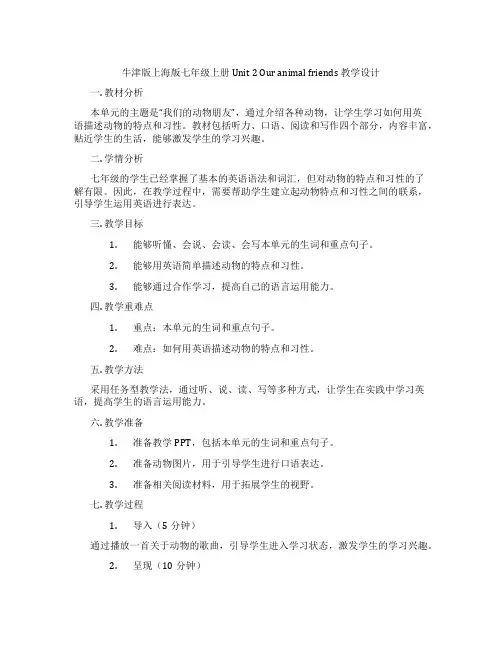
牛津版上海版七年级上册 Unit 2 Our animal friends 教学设计一. 教材分析本单元的主题是“我们的动物朋友”,通过介绍各种动物,让学生学习如何用英语描述动物的特点和习性。
教材包括听力、口语、阅读和写作四个部分,内容丰富,贴近学生的生活,能够激发学生的学习兴趣。
二. 学情分析七年级的学生已经掌握了基本的英语语法和词汇,但对动物的特点和习性的了解有限。
因此,在教学过程中,需要帮助学生建立起动物特点和习性之间的联系,引导学生运用英语进行表达。
三. 教学目标1.能够听懂、会说、会读、会写本单元的生词和重点句子。
2.能够用英语简单描述动物的特点和习性。
3.能够通过合作学习,提高自己的语言运用能力。
四. 教学重难点1.重点:本单元的生词和重点句子。
2.难点:如何用英语描述动物的特点和习性。
五. 教学方法采用任务型教学法,通过听、说、读、写等多种方式,让学生在实践中学习英语,提高学生的语言运用能力。
六. 教学准备1.准备教学PPT,包括本单元的生词和重点句子。
2.准备动物图片,用于引导学生进行口语表达。
3.准备相关阅读材料,用于拓展学生的视野。
七. 教学过程1.导入(5分钟)通过播放一首关于动物的歌曲,引导学生进入学习状态,激发学生的学习兴趣。
2.呈现(10分钟)利用PPT展示本单元的生词和重点句子,让学生进行朗读和书写练习。
3.操练(10分钟)学生分角色朗读对话,模拟真实场景,进行口语交际。
教师引导学生运用本单元的词汇和句型进行表达。
4.巩固(10分钟)学生分组进行讨论,每组选择一种动物,用英语描述该动物的特点和习性。
教师巡回指导,给予学生反馈。
5.拓展(10分钟)教师为学生提供相关阅读材料,让学生阅读并回答问题。
通过阅读,学生可以进一步了解动物的特点和习性。
6.小结(5分钟)教师对本节课的内容进行总结,强调本单元的生词和重点句子。
7.家庭作业(5分钟)学生回家后,用英语写一篇关于自己喜欢的动物的短文。
Unit2Our animal friendsPeriod Four教案Teaching PlanType:Look,rea d and mat chDesigning ideas:T ask-based and learner-centeredT eaching aims: e the simple past tense t o talk a bo u t past actionse the simple present tense t o express preferencesAbility aims:Further the students’ability in expressin g the animals the y like.T eaching points: 1.Listen for specific infor mation..e visual clues,context and knowledge of the world to work ou tthe meaning of unknown words.e appropriate in tonation and s tress t o convey intendedmeaningsDifficult points:Some sentence patterns.Learning strategies:Experiencing,cooperative and successful in learningT eaching procedure:S tages Teacher’s activities Students’activities PurposesPre-task Do some revision.Answer some questions.T o review the text.[Do fr ee talk Do you have a pet?What do you T othinkingcultivate thestudents’creativedo to look after your pet?Do you want to have a pet?Whyor why not?While-task Look and learn Look at some pictures and T o g et Ss familiarwith the newquestions and think the vocabularies.questions.a.Where did they live?In acave.b.How did they g et food?Theyh u n t e d for food.hunt---hu n t edLook,r ead match.and Look at the pictures and match T o help Ss e the sentences.familiar with the Come to the text text.R ead and answer.R ead the text t ogether and then T o ge t Ss f amiliaranswer some questions.with the sentencepatterns.P os t-task Listen and answer.Answer the questions.T o help students t obe familiar with thetextSummary T alk a bo u t the activities of the SPCA. Assignment1.Learn the vocabularies by heart.2.Do workbook.T o help Ss consolidate what they have learned in this period。
Unit 2 Our animal friends一. 教学内容:Module 4 RelationshipsUnit 2 Our animal friendsPeriod 2(一)课标单词(二)重点短语(三)语法知识(四)回答问题(五)写一写应该如何对待动物二. 知识总结与归纳(一)课标单词1. unkind2. c linic3. vet4. cave5. guard6. blind7. safely 8. police 9. thief10. missing 11. hunt(二)重点短语1. be unkind to sb2. look after3. save…from4. take sb to5. help sb do6. promise to7. get…from8. come back9. ask sb to do 10. many years ago11. keep sb (safe) from 12. in many different ways13. catch thieves 14. bring sb to(三)语法知识Imperative sentences 祈使句祈使句的含义:用于表达命令、请求、劝告、警告、禁止等的句子叫做祈使句。
祈使句的特点:通常省略主语。
通常以一般现在时的动词开始,句末则使用句号或感叹号1. 肯定结构:(1). 以Do开始动词原形(+宾语)+其它成分。
e.g.: Please have a seat here. 请这边坐。
有的祈使句在意思明确的情况下,动词可省略。
e.g.: This way, please. = Go this way, please. 请这边走。
(2). 以Be开始Be + 表语(名词或形容词)+其它成分。
e.g.: Be a good boy! 要做一个好孩子!2. 否定结构:(1). 在句首加Don’t构成否定句。
e.g.: Don’t forget me. 不要忘记我Don’t be late for school! 上学不要迟到!(2). 有些祈使句可用No开头,用来表示禁止性的祈使句e.g.: No smoking! 禁止吸烟!No fishing! 禁止钓鱼!3. 祈使句表达的不同含义Go and wash your hands. 去洗你的手。
七年级上U2复习教案一、同步知识梳理一.单词:officer n. 官员;高级职员 n.. office 办公室adj. official 官方的;正式的society n.. 社团;协会 adj. social 社会的prevention n.. 预防;防止;防范 v. prevent用法:prevent sb. from doing sth.cruelty n.. 残酷 adj. cruel : be cruel to sb. adv. cruellyas prep. 作为;当作如:work……as 以……为工作prefer v. 更喜欢用法:1) prefer to do sth. 喜欢做某事;2) prefer sth. 喜欢……3) prefer A to B 比起B来说,更喜欢A4) prefer doing A to doing B 比起B来说,更喜欢A5) prefer to do A rather than do B 宁愿做A, 而不做B。
care n. 照料;照顾 adj. careful / careless n. carefulness / carelessness词组: take care of 照顾safely adv. 安全地; adj. safe n. safetypolice n. 警方该词做警方解释时是集体名词,没有复数形式,但后面的谓语动词要用复数。
thief n. 窃贼;小偷复数形式是:thieves v. thieve 偷missing adj. 失踪的 a missing boy = a lost boy 迷路的男孩v. missadj. missed二.词组:照看好look after …… well为……筹钱raise money for……保证做…… promise to do ……守护我们的家 guard our homes在很多方面 in many ways对……残忍be cruel to ……找到失踪的人 find lost people保护……使免受…… protect …… from浅棕色 light brown阻止,使免于…… keep……from欢迎来到…… welcome to ……把……扔在马路上 leave something in the street.愿意做…… would like to do something给……一碗水喝 give somebody a bowl of water to drink把……作为宠物keep …… as somebody’s pet三.课文中的语法点need 的用法:need 是个重要的词。
牛津上海版英语七年级上册《Unit 2 Our animal friends》说课稿1一. 教材分析牛津上海版英语七年级上册《Unit 2 Our animal friends》是一篇以动物为主题的单元。
通过本单元的学习,学生将能够掌握关于动物的词汇和句型,提高他们的听说读写能力。
教材内容丰富,插图生动有趣,能够激发学生的学习兴趣。
此外,教材还注重培养学生的观察能力、思维能力和合作能力。
二. 学情分析七年级的学生已经具备了一定的英语基础,他们对学习英语充满热情。
但部分学生可能在听说方面存在一定的困难,因此需要在教学中给予他们更多的关注和指导。
此外,学生在本单元的学习中需要掌握一些关于动物的词汇,因此,在教学前,教师应了解学生对动物词汇的掌握情况,以便进行针对性的教学。
三. 说教学目标1.知识目标:学生能掌握本单元的生词和短语,了解动物的特点,提高他们的词汇量和语言运用能力。
2.能力目标:学生能运用所学知识进行简单的交流,提高他们的听说读写能力。
3.情感目标:培养学生关爱动物、保护环境的意识,提高他们的道德素养。
四. 说教学重难点1.教学重点:学生能掌握本单元的生词和短语,正确运用句型进行交流。
2.教学难点:学生能正确发音和运用词汇描述动物的特点。
五. 说教学方法与手段1.教学方法:采用任务型教学法、情境教学法和交际法,激发学生的学习兴趣,提高他们的参与度。
2.教学手段:利用多媒体课件、图片、卡片等辅助教学,创设生动有趣的学习氛围。
六. 说教学过程1.导入:教师通过提问方式引导学生谈论他们喜欢的动物,激发学生的学习兴趣。
2.呈现:教师展示本节课的生词和短语,引导学生跟读,确保正确发音。
3.操练:教师学生进行小组活动,用所学句型介绍动物的特点。
4.实践:教师创设情境,让学生运用所学知识进行角色扮演,提高他们的实际应用能力。
5.巩固:教师通过游戏、练习等方式检查学生对本单元知识的掌握情况。
6.拓展:教师引导学生谈论动物的保护,培养他们的环保意识。